“Tomorrow is Yesterday”
Written by D.C. Fontana
Directed by Michael O’Herlihy
Season 1, Episodes 21
Production episode 6149-21
Original air date: January 26, 1967
Stardate: 3113.2
Captain’s log. We open at an Air Force Base in 1969, which picks up a giant aircraft like nothing they’ve ever seen before, and it just appeared out of nowhere, “like it dropped out of the sky.” A plane is scrambled to get a better look, and we see that it’s the Enterprise. They collided with a black hole (they call it a “black star”) while en route to Starbase 9, and wound up at Earth. Scotty manages to get power back online, but warp drive is offline. Sulu reports that the impulse drive is sluggish, but he gets them some altitude. Uhura reports silence on the usual Starfleet channels—all she’s able to get is radio, including an announcement of the upcoming first moon landing. This confirms Spock’s hypothesis that the black star sent them back in time to the 20th century.
The pilot sent to investigate, Captain John Christopher, pursues, getting close enough to see the Enterprise. He’s ordered to bring down the UFO. Uhura picks up the conversation between Christopher and the base, and Spock expresses a concern that the plane can do damage to the Enterprise in its current state. Kirk has Scotty put the plane in a tractor beam, but the aircraft is too fragile and starts to break up. Kirk has Christopher beamed on board. The captain is surprised that they speak English, and offers only name, rank, and serial number.
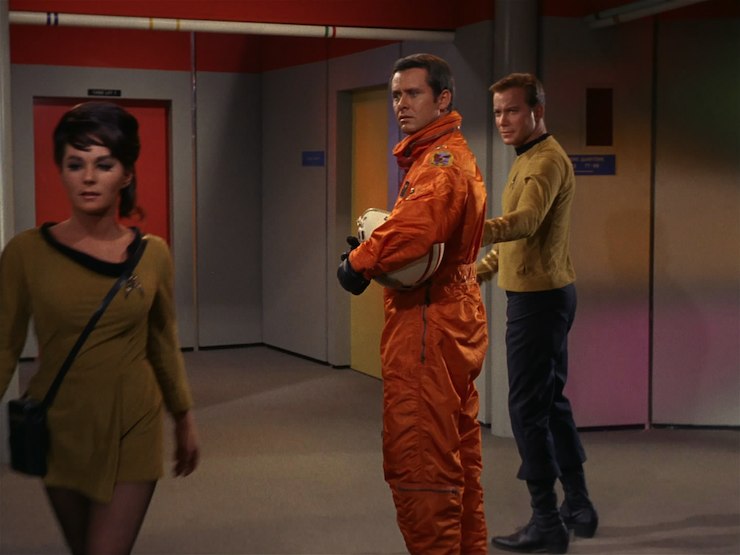
Christopher is angry and confused, and Kirk goes ahead and tells the truth: they’re from the future. Given the evidence, Christopher can’t help but believe him—especially after he meets Spock…
While Uhura shows Christopher around the bridge, Spock reports that they’re in a high orbit with deflectors working, so the locals won’t pick them up on their radar anymore. He’s also concerned about Christopher, as he now has knowledge of the future, which could change history. Kirk orders the quartermaster to provide Christopher with more suitable clothes and then meet him and Spock in the captain’s quarters.
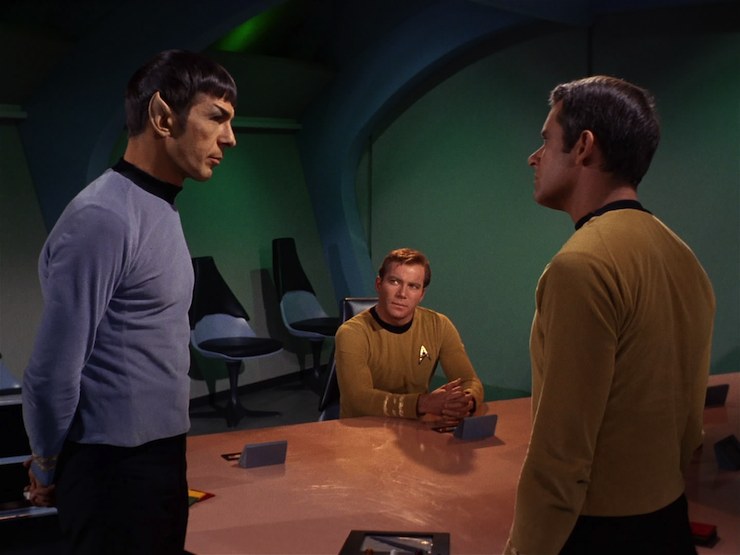
Christopher arrives wearing a lieutenant’s uniform (which fits, as the Air Force rank of captain is equivalent to the Navy rank of lieutenant, and Starfleet uses Navy ranks) as Kirk is recording a log entry, and then explains to Christopher that they can’t send him back. Christopher points out that his disappearance would also change history, but Spock has checked—there is no relevant contribution by John Christopher in their history tapes. (Tapes!) Christopher points out that he’s duty bound to report what he’s seen, a problem Kirk can sympathize with, and he has a wife and two kids down on Earth. But Kirk can’t take the risk.
Scotty then reports that repairs should be completed in four hours—but that leaves them with nowhere to actually go. Christopher may not be able to go home, but neither can Kirk and his crew.
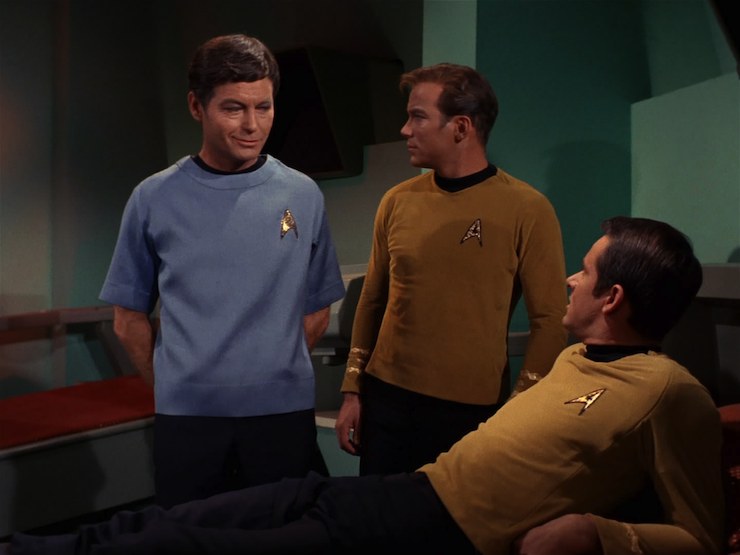
Christopher has free run of the ship, which proves to be a mistake, as Kirk notices that he’s not in his quarters and puts the ship on security alert. Christopher takes down a security guard, steals a phaser, and tries to convince Transporter Chief Kyle to beam him down. But Kirk shows up and punches him in a manly manner, sending him to sickbay unconscious.
Spock reveals that he didn’t make a thorough enough search: Christopher didn’t make any relevant contributions, but his son will. This rather surprises Christopher, as he doesn’t have a son—at least not yet. So they have to return him, or alter history forever. The other issue is the fact that Christopher activated his wing cameras when he came in visual range of the Enterprise, and Air Defense Command will have made recordings of all his transmissions. Those need to be destroyed, as the wreckage of Christopher’s aircraft (and the lack of a body), as well as the recorded evidence will point to a spacecraft, seemingly of alien design, definitely destructive.
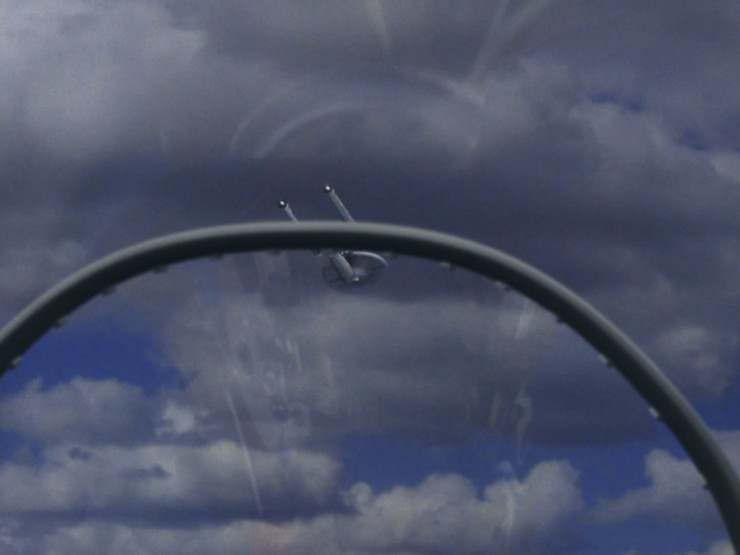
Christopher is willing to help, even though it will make his flight out to be the latest in a long line of UFO sightings with no evidence to back it up. He was stationed at the base, and knows the layout, and he sketches it for them, and tells them where to go to find what they need.
Kirk and Sulu beam down, briefly amused by the primitive cork bulletin board. They use a doodad to open the locked door to the records room. As they’re sabotaging the computer, a sergeant catches them and takes their belts. He looks at one communicator and activates the emergency signal, which causes Kyle to beam the sergeant up to the Enterprise. At least they still have one communicator and their phasers. Kirk orders the sergeant kept in the transporter room (which works nicely, as the guard is scared shitless and hasn’t budged).
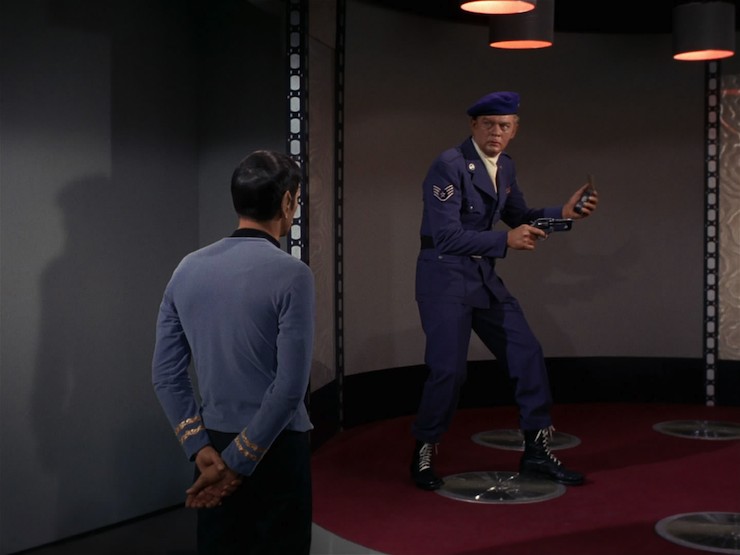
After taking all the computer tapes, Kirk and Sulu go after the film. They find the film in the darkroom. Kirk goes to check the files and finds three officers who are following up the alarm that they didn’t realize they’d tripped. Kirk takes on all three of them, but eventually is taken prisoner. Luckily, Sulu heard the fight, knew it was meant as a delaying action so he could beam back aboard, and he did so, with all the evidence. The problem is, Kirk doesn’t have a communicator, so they can’t distinguish him from all the other humans wandering around the base, so they can’t locate him to beam him back.
Kirk is interrogated by Lt. Colonel Fellini, which pretty much goes nowhere, since the colonel won’t believe the truth and anything else would be a lie.
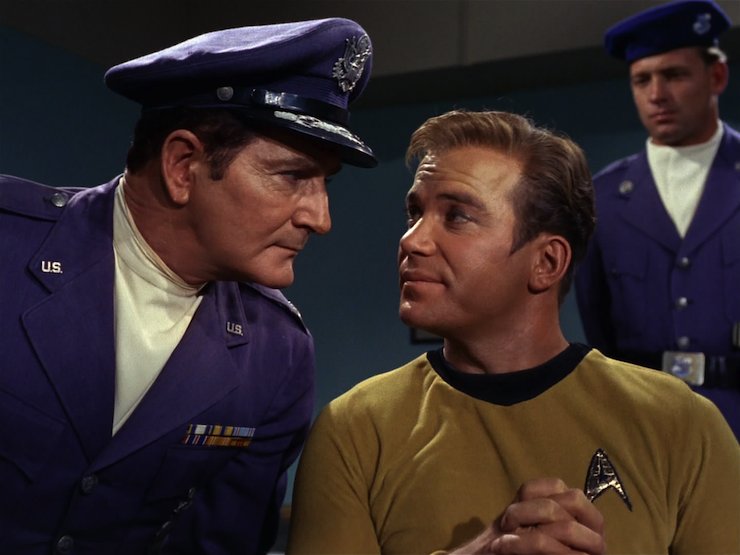
Christopher knows where they’re holding Kirk, but he’ll only provide the coordinates if he goes down with him. Spock, Sulu, and Christopher beam down—only Spock and Sulu are armed—while the sergeant looks on in shock. He’s even more shocked when Kyle activates the food slot and gives the sergeant some chicken soup.
The landing party effects a rescue, and then Christopher takes the gun of the airman Spock subdued and holds it on the Enterprise crew. However, Spock doubles back and sneaks up on Christopher from behind.

Spock and Scotty know of a theory that would enable them to travel in time by slingshotting around the sun. It’s risky, but it’s their only shot. The initial shot will send them back in time a bit, which is when they will beam Christopher and the sergeant back.
They head toward the sun. Christopher is overwhelmed—he didn’t qualify for the space program—but Kirk smiles and says to take a look around: he got there ahead of everyone else.
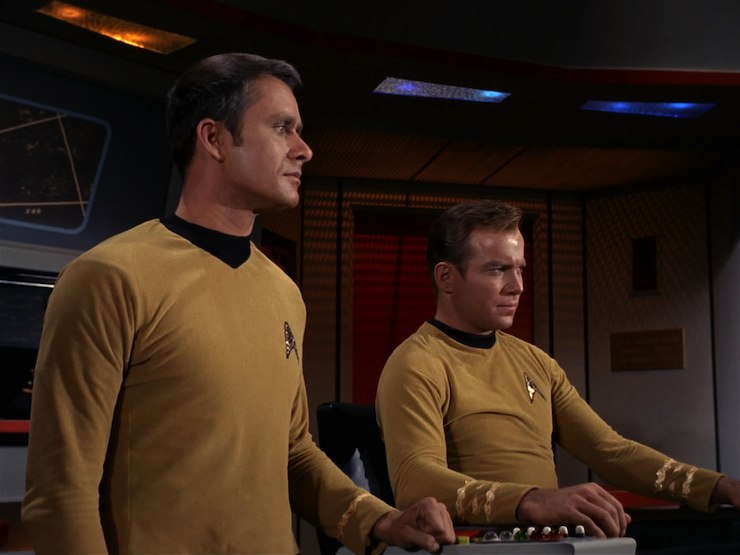
Christopher goes to the transporter room. The Enterprise accelerates toward the sun, they hit the breakaway point, and zoom around the sun. They beam Christopher back into his aircraft right at the point where he saw the Enterprise, and now he sees nothing. Uhura picks up his transmissions, confirming that they’re chalking it up as another UFO. They then beam the sergeant back just before he would have broken in on Sulu and Kirk and he sees nothing.
The Enterprise continues forward in time, and then Scotty hits the brakes. Uhura picks up a message from Starfleet Control, and all is well.
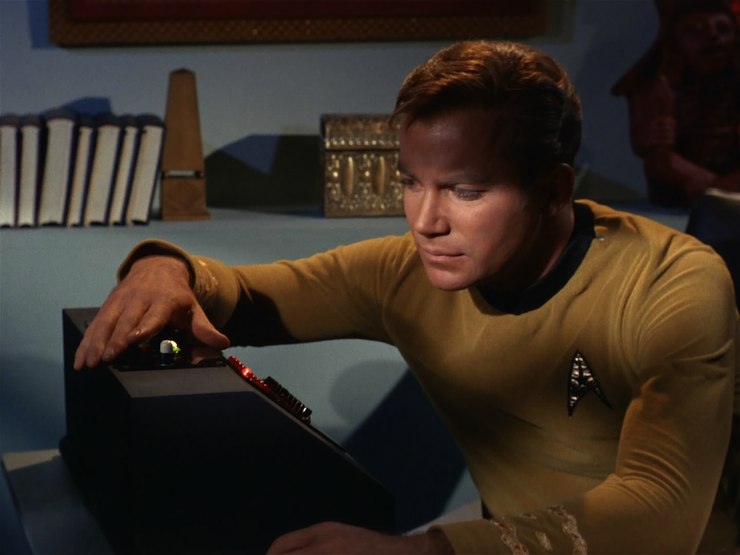
Can’t we just reverse the polarity? The Enterprise computers were recently overhauled at Cygnet XIV, a female-dominated planet, and they felt the computer lacked personality, so they gave it an amorous, giggly female personality. Spock’s disdain and Kirk’s annoyance provide Christopher with amusement—I guess it’s funny that the future is just as sexist as 1969…
Fascinating. Both Christopher and the sergeant are seriously weirded out by Spock, though Christopher gets over it eventually, to the point where he’s actually engaged in bitter banter with Spock on the subject of trust.
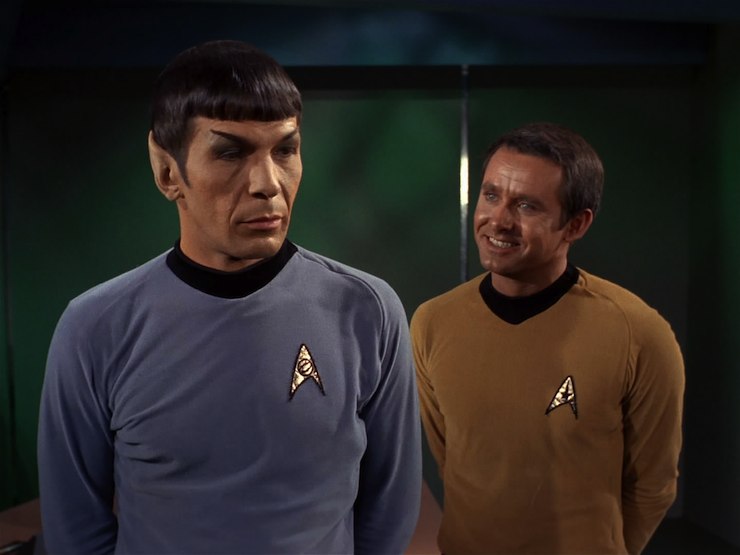
I’m a doctor not an escalator. McCoy has a serious discussion with Kirk on the subject of both the possibility of Christopher being stuck in the 23rd century and the Enterprise crew being stuck in the 20th. He also gets great amusement out of Spock admitting to being in error.
Ahead warp one, aye. Sulu does most of the sabotaging, engages in some quick thinking by beaming out the darkroom while Kirk indulges in fisticuffs, and works with Christopher and Spock to rescue Kirk. As an added bonus, he flies the ship during the time jump.
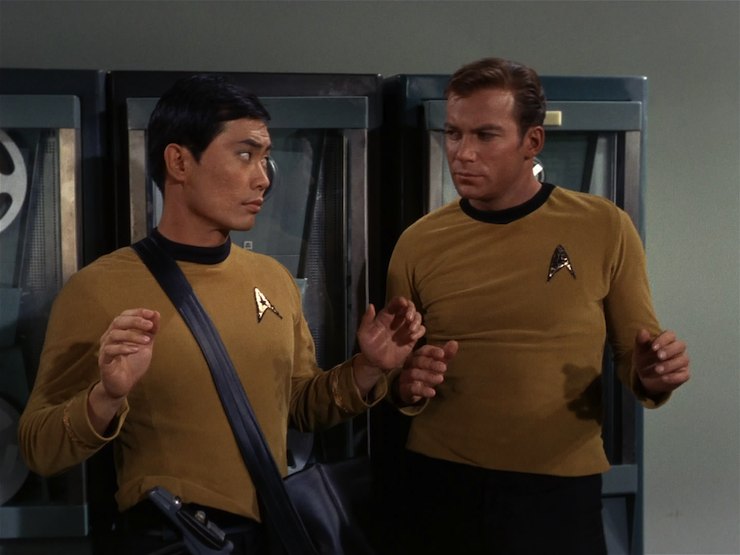
I cannot change the laws of physics! Scotty works with Spock on the slingshot, and repeatedly cautions against everything that could possibly go wrong.
Hailing frequencies open. Uhura is the first one to figure out that something’s amiss when she picks up radio broadcasts.
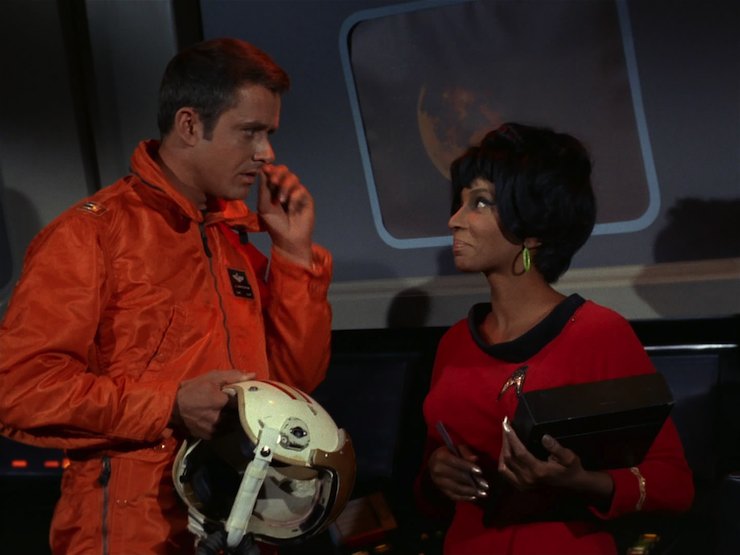
Go put on a red shirt. Security is so good at their jobs that they utterly fail to keep Christopher from going to the transporter room. One guard even gets kayo’d, and his phaser taken by Christopher. It’s left to Kirk to take care of it…
Channel open. “All right, Colonel, the truth is, I’m a little green man from Alpha Centauri, it’s a beautiful place, you should see it.”
“I am going to lock you up for two hundred years.”
“That ought to be just about right.”
Kirk being interrogated by Fellini.
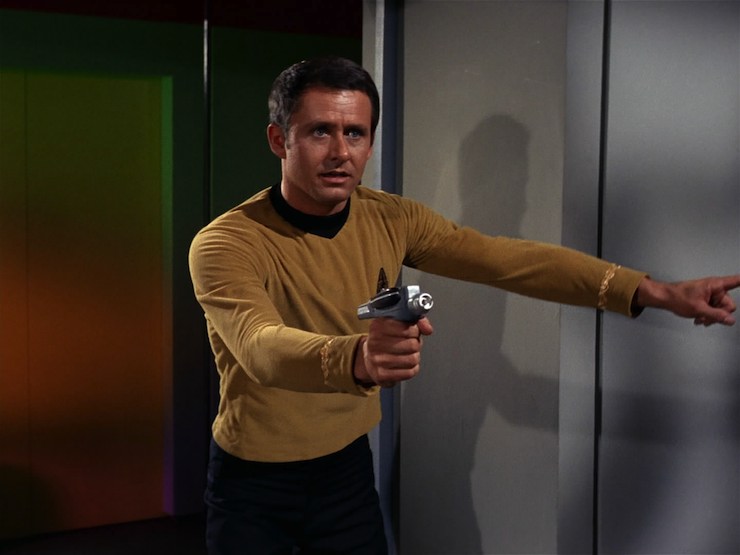
Welcome aboard. Roger Perry plays Christopher (he’s credited incorrectly as “Major Christopher”), Hal Lynch plays the sergeant, Richard Merrifield and Mark Dempsey play the Air Force personnel who first discover the Enterprise, and the great character actor Ed Peck plays Fellini.
Plus there’s recurring regulars DeForest Kelley, George Takei, James Doohan, Nichelle Nichols, and, making his first appearance, John Winston as Transporter Chief Kyle.
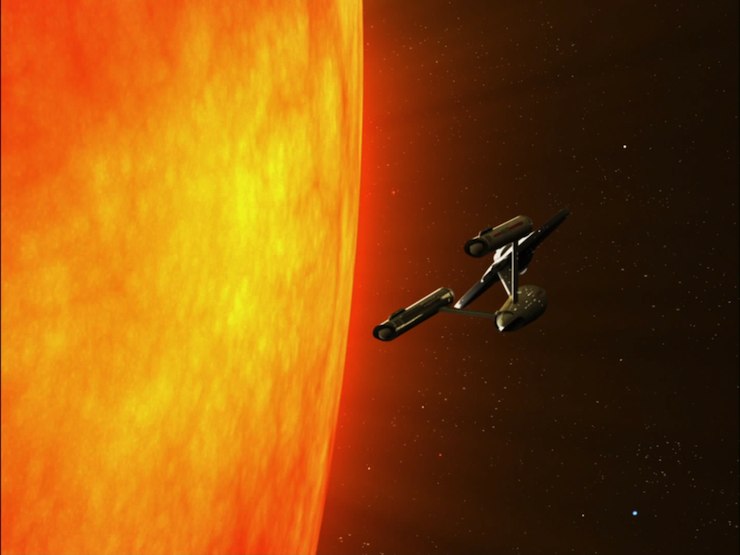
Trivial matters: This is the first solo writing credit for D.C. Fontana, after scripting “Charlie X” off of Gene Roddenberry’s story, who would go on to become one of the most important and influential writers in Trek history. She’d become a script editor on this show, and also work on the animated series, help develop The Next Generation, and write for both TNG and DS9, as well as several novels, comic books, videogames, and episodes of fan films. (Robert H. Justman, in his and Herbert Solow’s book Inside Star Trek: The Real Story, reveal that he came up with the story idea and gave it to Fontana to write, but he was not credited.)
The script accurately predicted that the first moon landing would occur two-and-a-half years hence in 1969.
The original intent was for this episode to follow “The Naked Time,” with the cold restart of the engines causing the Enterprise to go back to 1969, but production schedules and air date shuffling made this pretty much impossible.
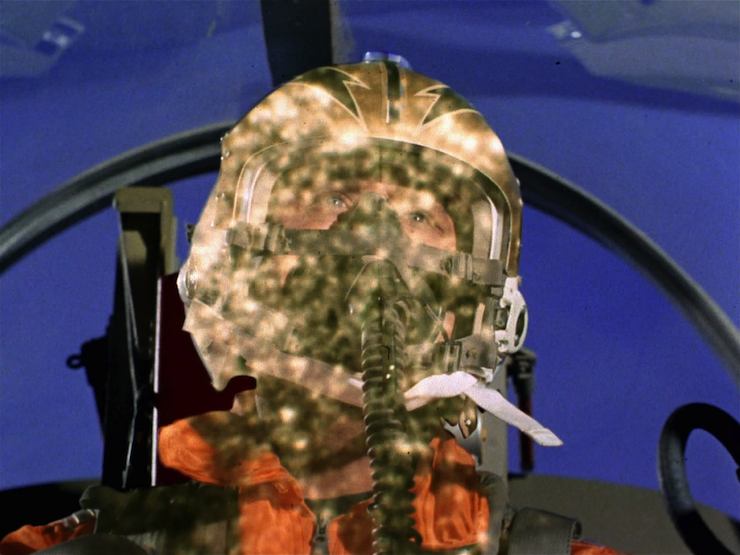
Twice more, the Enterprise will use the slingshot to travel in time, first in “Assignment: Earth” to do research, and again in Star Trek IV: The Voyage Home to find some humpback whales to bring to the future and save Earth. It’ll also be seen in various bits of tie-in fiction, including Engines of Destiny by Gene DeWeese and the New Frontier comic book Double Time by Peter David and Mike Collins.
Dayton Ward’s short story “The Aliens are Coming!” in Strange New Worlds III and novel From History’s Shadow would provide the aftermath of this story, as Christopher is debriefed by Wainwright, one of the officers who encountered Quark, Rom, and Nog in 1947 Roswell in DS9‘s “Little Green Men.” Shaun Geoffrey Christopher, the captain’s as-yet-unborn son, appears in Greg Cox’s The Eugenics Wars: The Rise and Fall of Khan Noonien Singh and The Rings of Time. Gary Seven, whom we’ll meet in “Assignment: Earth,” also played a background role in the events of this episode, as seen in issue #2 of the Assignment: Earth comic book miniseries by John Byrne.
The day after this episode was aired, the Apollo 1 tragedy occurred, taking the lives of Gus Grissom, Ed White, and Roger Chaffee.
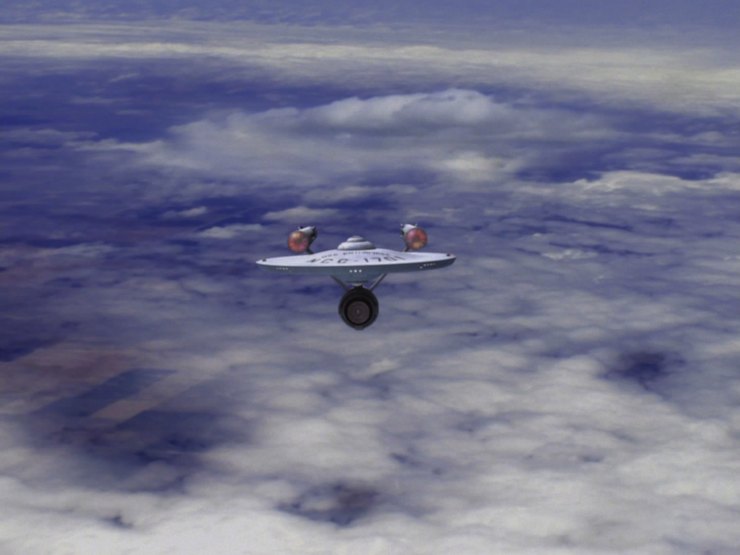
This episode establishes that there are twelve Constitution-class ships.
The term “black hole” would not be coined until later the same year that this episode first aired, by physicist John Archibald Wheeler in a speech to NASA.
To boldly go. “Thanks for the look ahead.” Star Trek‘s first real time travel story—though far from its last—is quite an enjoyable tale, although the logic of the ending doesn’t hold together at all. Seriously, how does it make any sense that going back a bit in time and somehow replacing people with the transporter will make them forget everything that happened? Or make it not happen. Or something.
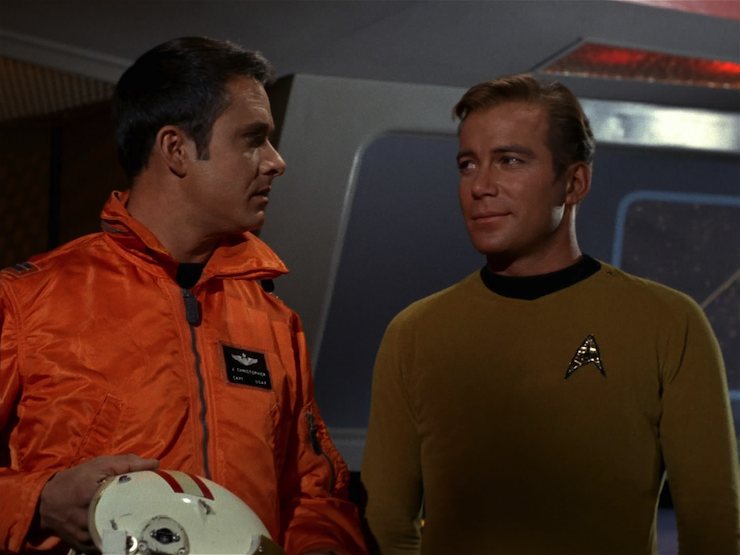
But prior to that, it’s a very entertaining episode. A lot of it is on the back of Roger Perry, who imbues Christopher with a distinct personality, and D.C. Fontana’s script, which not only gives Christopher credit for being an intelligent person, but also does a nice job of showing that just because humans have better technology doesn’t mean they’re perfect. (Though the “female personality” computer subplot is pathetic and embarrassing even before you realize that it was written by a woman.) I like the fact that the crew screws up, starting with using the tractor beam on Christopher’s plane, and going on to beaming the sergeant up, not to mention Spock’s incomplete research. I also like how smug Christopher is when pointing it out.
Having said that, the crew doesn’t get caught up in their screw-ups, but move quickly to fix them, from their plan to remove the evidence to Sulu’s quick thinking in beaming back from the darkroom to the slingshot—which we’ll see again. The episode has a good balance of serious danger—the notion of being trapped in the 20th century is a powerful one—and humor—from McCoy’s snark to Hal Lynch’s superb comic work as the befuddled sergeant to Fellini’s interrogation of Kirk.
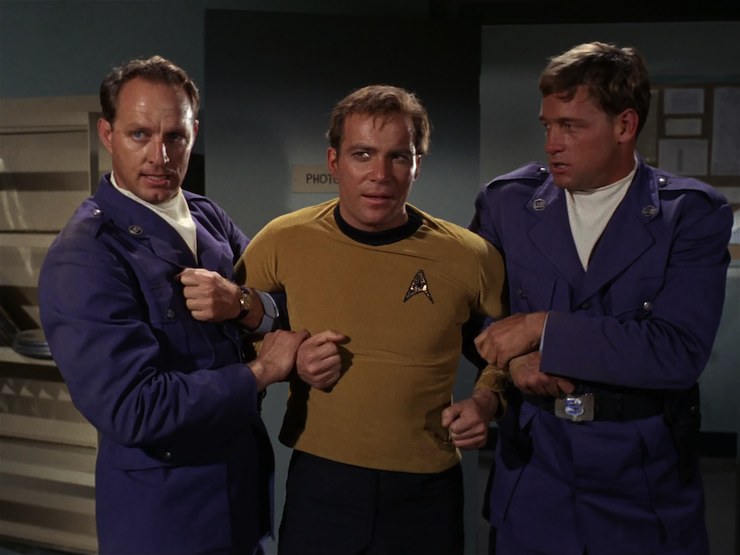
Overall, a good time travel story with a strong guest star. Many time-travel clichés grew out of this episode, but the episode itself is a good one.
Warp factor rating: 8
Next week: “The Return of the Archons”
Rewatcher’s note: We’re in the home stretch for a very nifty Kickstarter for a superhero flipbook anthology called The Side of Good/The Side of Evil, for which your humble rewatcher will be writing a Super City Police Department story, and which will also have a new Furious story by Bryan J.L. Glass, as well as tales by Star Trek fictioneers Peter David, Aaron Rosenberg, and Robert Greenberger, as well as Jennifer K. Spendlove, James Chambers, Gail Z. Martin, John L. French, James M. Ward, Neal Levin, and Kathleen O. David. The anthology will be edited by veteran anthologist Danielle Ackley-McPhail and Between Books‘s Greg Schauer, and there are tons of nifty rewards, including bonus fiction and a chance to be a character in one of the stories. Please lend your support!
Keith R.A. DeCandido will be at Shore Leave 37 this weekend at the Hunt Valley Inn in Cockeysville, Maryland, along with actors John Barrowman, David Nykl, Jaime Murray, Tony Curran, Jesse Rath, Rekha Sharma, Daniel Davis, and Roger Cross; fellow Trek novelists Christopher L. Bennett, Kirsten Beyer, Peter David, Kevin Dilmore, Michael Jan Friedman, Dave Galanter, Robert Greenberger; David Mack, John Jackson Miller, Scott Pearson, Dayton Ward, and Howard Weinstein; fellow Stargate novelists Amy Griswold and Melissa Scott; and tons and tons more too numerous to list here. Keith’s schedule can be found here.










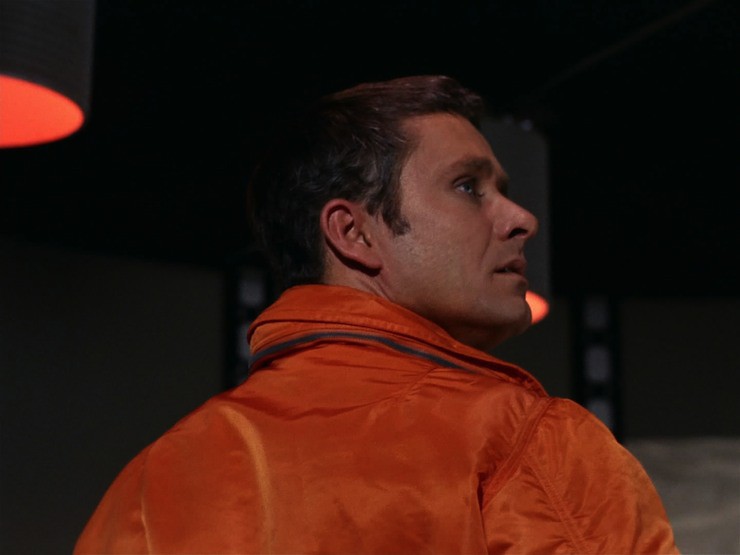
I don’t mind the “female personality” for the computer at all, for this reason:
We know this:
1) It was programmed by women.
2) It annoys and embarrasses Kirk.
CONCLUSION: What makes you think they were being seductive? Why isn’t it more reasonable to conclude that they were doing it SPECIFICALLY because it would annoy and embarrass Kirk? 430 crewmembers knowing that they did this TO KIRK, and being reminded of that every single time they accessed the computer…
I think he pissed off that female-dominated planet, by being himself.
I think they were trolling him. With beautiful sarcasm.
Adam: never thought of that interpretation. Fascinating…
—Keith R.A. DeCandido
#1
I agree. Especially looking back at this episode with the reputation Kirk has now as a ladies’ man and destroyer of computers, it’s funny to see a “female computer” give him grief.
I find it a very easy “prediction” for this episode to put the moon shot in 1969, given that the Apollo schedule was incredibly tight, hewing to Kennedy’s declaration that we must land on the moon “before this decade is out.” :)
I thought the reason this was divorced from “The Naked Time” was because of Roddenberry’s decision not to have continuity between episodes, so that the network could air them in any order.
I addressed the weird science of this episode in both my DTI novels, Watching the Clock and Forgotten History, the latter of which dramatizes the immediate aftermath of the episode and Starfleet’s reaction to the new reality of time travel. Both books offer an explanation for how beaming people into their own past bodies could have the effect shown. It almost makes sense in quantum-physics terms. Two different temporal versions of a person are basically different quantum states of their particles, and if you combine the two by beaming them into the same place and time, quantum information theory requires that only one set of quantum states must survive. (Which means they essentially killed the versions of Christopher and the Sergeant that they’d interacted with.)
I actually had more trouble explaining why a tractor beam would destroy a jet. A tractor beam is basically a gravity laser, and gravity pulls on every part of an object evenly. So there’d be no differential strain on the various parts of the aircraft (unless we’re talking a tidal gradient like that near a neutron star). I rationalized it by saying that the altered gravity vector made the plane react as though it were tipped nose-down, basically, so it was ripped apart by the unbalanced aerodynamic forces.
It’s a popular meme that this episode predicted when the first lunar landing would be, but it didn’t actually specify a 1969 date. In fact, James Blish’s adaptation sets it in the 1970s. What it does specify is that “the first manned moon shot” would be on a Wednesday, which has been retroactively interpreted to refer to the launch of Apollo 11 on Wednesday, July 16, 1969. But I think that, technically, the phrase “the first manned moon shot” would be more applicable to Apollo 8, in which Frank Borman, James Lovell, and William Anders left Earth orbit and circled the Moon for 20 hours before returning to Earth. The phrase “moon shot” is broad enough to encompass a mission that merely orbits the Moon as well as one that lands on it. So any reporter talking about Apollo 11 in the summer of 1969 would have remembered the mission from six months earlier, and thus would probably have called it something like “the first attempt to land on the Moon” rather than “the first manned moon shot.” This would suggest that TiY actually took place in mid-December of 1968. However, Apollo 8’s December 21 launch date fell on a Saturday, and there’s no evidence that it was ever expected to fall on a Wednesday. Neither date fits the line perfectly (since it was coincidence, of course), but fans tend to assume the episode fell in 1969.
To me, TiY’s prediction of a Wednesday moon launch is not nearly as impressive as the fact that it anticipated Frank Tipler’s famous 1973 paper “Rotating cylinders and the possibility of global causality violation” (available at http://theophysics.host56.com/pdf/tipler-rotating-cylinders.pdf) proposing that a path around a dense rotating mass could create a “closed timelike curve” and allow an object to intersect its own past, i.e. travel backward in time. It’s startling that Trek’s first real time-travel episode came so close to predicting the future in two different ways (although it just missed predicting the term “black hole”).
This episode successfully predicted that the moonshot would be launched on a Wednesday!
Didn’t Fontana write the script for Charlie X?
I wrote my comment while Bennett was writing his and making good points about the moonshot. Sorry!
#5
The jet being an F-104, it’s not too difficult to believe anything stronger than a sneeze could break it apart. From what I’ve read of the aircraft, they were already unbalanced to say the least.
I was going to make the same point about D.C. Fontana and “Charlie X”…
@5 I’ll be picky,and point out that a literal “gravity laser” would be emitting gravity waves, which would stretch and squeeze objects in its path, not attract them.
To be less picky: real beams of light and radio waves, like real magnetic and electric fields, are never perfectly homogenous. It is quite possible that the strength of the tractor beam would vary between the centre of the beam and its edge and would put additional stresses on an airframe that may have been close to the edge of its performance envelope anyway.
BTW – beaming someone back in time might not eliminate someones memories, but it would eliminate any evidence they were true. If you were that USAF captain, would you want to tell your superiors what you could remember of the Enterprise? What would happen to you if you did?
Another childhood favorite that still holds up as an adult.Sure, the ending makes no sense, but the rest of the episode is top-notch: good tension, strong comedy beats, solid supporting players, etc.
Grade: 8
I was surprised by how easily that they believed that they time traveled. There was no “Maybe our circuit that receives Starfleet channels is blown out. Somebody’s probably broadcasting some historical program, for school or something.” Nope, directly to the least probable option.
@5 Christopher L Bennett:”So any reporter talking about Apollo 11 in the summer of 1969 would have remembered the mission from six months earlier, and thus would probably have called it something like “the first attempt to land on the Moon” rather than “the first manned moon shot.”
Maybe.Out of curiosity, I did do a quick GOOGLE search and I found this:
https://news.google.com/newspapers?nid=1915&dat=19690705&id=ag8hAAAAIBAJ&sjid=yXYFAAAAIBAJ&pg=1043,764704&hl=en
MOON SHOT TO BE 33rd SPACE FLIGHT FOR MAN
https://news.google.com/newspapers?nid=2245&dat=19690603&id=XRw_AAAAIBAJ&sjid=Qk8MAAAAIBAJ&pg=5361,5455685&hl=en
APOLLO 11 MOON SHOT SET FOR JULY
https://news.google.com/newspapers?nid=1368&dat=19690715&id=HnRQAAAAIBAJ&sjid=NREEAAAAIBAJ&pg=6942,2869499&hl=en
NETWORKS PREVIEW APOLLO 11 MOON SHOT
https://news.google.com/newspapers?nid=2245&dat=19690612&id=ZRw_AAAAIBAJ&sjid=Qk8MAAAAIBAJ&pg=7133,6470886&hl=en
APOLLO 11 MOON SHOT OKAYED FOR JULY 16
So it does seem that newspapers referred to Apollo 11 as a Moon Shot.
@1 Exactly the theory I was always going with too.
Don’t make me say “Timey-Wimey”, you know I will {g}
I like to think that in an alternate universe they beamed him down on an empty island somewhere. Did I say empty? I mean, empty apart from a vaguely Arabian Nights-esque looking bottle… But that is another fanfic entirely.
@12/Cloric: But they didn’t rely solely on the broadcast. After Spock said they were apparently in the late 1960s, he said he was waiting for exact chronometer readings. Presumably, while the others were listening to the broadcast, he was calculating the time from star and planet positions, pulsar rates, and the like. And of course it would’ve been easy to tell the difference between 20th- and 23rd-century Earth just by looking at the cities, landforms, pollution levels (cf. The Voyage Home), etc. So he didn’t just guess — he reported that his sensor readings corroborated the evidence of the broadcast. The script just skipped over the details of how he determined that.
@15 CLB, and I’m perfectly willing to accept that explanation, even if I like my logic to look less leapy.
I so rarely get to nitpick since I’m not good at remembering specific story details, but I think I caught an opportunity here (proud face):
“Twice more, the Enterprise will use the slingshot to travel in time, first in “Assignment: Earth” to do research, and again in Star Trek IV: The Voyage Home to find some humpback whales to bring to the future and save Earth.”
I don’t think it was the Enterprise that traveled in time in ST IV, it was a Klingon ship. This could be edited to say “the Enterprise crew”.
Ok, nitpick over. Thanks for indulging me.
@17 You’re absolutely right. To be specific, the ship travelling back in time in Star Trek IV was a Bird of Prey that had been named “The Bounty” by its new owners.
My take on why the tractor beam resulted in the destruction of the airplane was pretty simple. If you imagine the tractor beam suddenly pops up and “grabs” the airplane while its doing something close to – if not exceeding – Mach, and the engines are still pushing the jet, then you’re gonna have a buttload of stress on the airframe that it wasn’t designed to handle.
Its like if you’re going down the highway at 70mph and a brick wall appears in front of you, only the airplane was going 10 times faster.
So, not a single comment or mention that this episode was based on an uncredited Story Idea by Associate Producer Bob Justman? (okay, I’ve read Inside Star Trek: The Real Story a gazillion times over the years, where this is documented)
The reasoning behind keeping Christopher does not hold up. Unless their records that disappeared or was presumed dead he could have had actions that had major consequences down the line that nobody knew about, like maybe accidently running over a boy named Singh with his car a year hence or even more innocuous. I guess Spock was not familiar with chaos theory (heh).
Was the first lunar landing scheduled in mid-1969 at this point? As KRAD wrote the Apollo 1 fire happened shortly after this aired which disrupted the launch schedule well over a year as NASA tried to figure what went wrong and how to deal with it. There were some scheduled warm-up missions that were eliminated or changed, Either NASA was working at breakneck speed to finish the preliminary Apollo flights by the middle of ’69 or the lunar landing mission should have happened in ’68 at the
I’ve adjusted the first paragraph of Trivial matters regarding Fontana to address the concerns raised in the comments. :)
—Keith R.A. DeCandido
Shaun Jeffrey Christopher was also a main character in Greg Cox’s TOS novel The Rings of Time which portrayed a rather unique and peculiar interaction between the twenty-first and twenty-third centuries!!
One line in this otherwise great episode bugged me:
When Christopher was wondering about being in space and Kirk told him he’s the first one. What about Juri Gagarin? I know it could be interpreted as “the first one going so far”, but still…
@21/Crusader75: No, there were a lot of uncertainties and delays in the Apollo program, so there wouldn’t have been a firm advance schedule. The episode itself only narrowed it down to “the late 1960s,” and as I said, Blish’s adaptation (published in 1968) bumped it to the ’70s, which Blish presumably thought was more likely.
@24/salix_caprea: Kirk’s line was “You made it here ahead of all of them.” When he said it, the ship had just left Earth orbit, so “here” presumably meant “beyond Lunar orbit.”
@14 It’s not only the concept of “erasing” the memories of the “historical” people that gets dropped in later Star Trek episodes and series, it’s also the concept that the conditions for time-travel are incredibly rare and difficult to achieve. By the time of the DS9 episode “Trials and Tribble-ations,” it’s apparently become so commonplace that there’s an entire Starfleet agency set up to deal with it.
Same thing happened with accessing the “mirror universe.” In “Mirror, Mirror,” it takes a convergence of circumstances of nearly cosmic coincidence to do so, but by the later seasons of DS9, getting there seems to have become about as difficult as catching a crosstown bus.
This was the second episode I bought on VHS back in the 1990’s. And one of my favorites. A well written time-travel story, with great characterization, a very tight plot and manageable stakes. Great guest presence by Christopher. A very original character who manages to interact well with the crew. In fact, I feel every character gets pretty well serviced, even though this is a very plot driven scenario. Easily one of season 1’s best.
It’s no wonder Fontana became the most prolific and consistent Trek writer (or at least until Ron Moore and Brannon Braga joined the franchise). Fontana’s known for penning the Spock-centric shows, and her honest preference for the character. Therefore, it’s nice we get to see a Fontana-written episode that isn’t entirely about him, but about the crew working together as a consistent whole.
My only quibble with this has to be the convenient Deus Ex-Machina ending, replacing characters and their memories on the fly through the transporter. It doesn’t feel remotely credible, but I’ve found reading Christopher’s take on this particular bit of weird science to be quite interesting.
@26: From a writer’s point of view, when you go back to the same well, you don’t want to get bogged down on the intrincacies of time travel or dimension-shifting, since it keeps you from telling the story you want to tell. You assume viewers already know how the process works, which saves you storytelling time.
@5: Interesting scientific take. You could say they killed this version of Christopher along with his memories. In many ways, this reminds me of Voyager’s Tuvix and Janeway’s questionable decision, which we all know the outcome.
This is the first episode of the first season of Star Trek in Germany, and the first one I ever watched. I turned on the TV somewhere in the middle of the episode, when Kirk and Sulu were sabotaging the base. Then came the fistfight, and then that lovely interrogation scene, and that was when I decided I loved this show. I never found out what the episode was actually about until the next rerun four years later.
Of course, another possibility is that the tractor beam was one of things damaged when they got sent back in time, but no one noticed this till Christopher’s plane got torn apart instead of drawn in. It’s just that their first reaction was to say it must be something wrong with the plane (“Hey, it’s not my fault crummy, 20th century technology can’t handle this”).
Tractor beams ought to be designed as rescue devices that can pull in badly damaged craft, not just things to capture escaping ships. They also should be able to move odd objects found in space for closer examinations. Any of these might be extremely fragile and on the verge of breaking up. So, a tractor beam ought to be designed not to damage them.
Although, what would be ideal and what the current science and technology can do may not be the same thing. Still, I’m betting on tractor beam malfunction.
DonRudolphII: Greg himself also mentioned that on Facebook. I’ve edited the entry. :)
—Keith R.A. DeCandido
There has to be someone reading this rewatch that knows the science-fiction/theory of why going around the sun at warp speed would result in time travel.
I’ve wondered about this ever since Star Trek IV (which I saw before this episode)…only b/c when Kirk says “we’ve done it before” I was like “uh, when!?” and found this episode.
If nobody knows that’s ok too.
@31/Danis: See the link to the Frank Tipler paper in my initial post above. Theoretically, you actually could go back in time by traveling through the distorted spacetime around a rapidly rotating black hole. Technically, it shouldn’t work with an ordinary star, which doesn’t induce enough of a frame-dragging effect on the spacetime around it, but since the ship was at warp, that might’ve provided the necessary distortion.
Curiously, I ffnd myself suspending all disbelief about the scientific problems in this episode and just accept that it’s one of TOS’s better stories and in general good Star Trek.
What I end up obsessively nitpicking about instead is that first Spock said that Christopher made no “relevant” contribution to history. Later on when he finds out about Shaun Christopher and says they have to return him after all, Christopher says, “You said I made no relative contribution to history”, to which Spock replies “A poor choice of words on my part.” It would have made a cool pun on the word “relative”, only Spock didn’t say “relative” the first time; he said “relevant”.
Maybe Spock was too polite to say “A poor choice of words on your part” to Christopher and took responsibility for the gaffe himself despite being innocent of it.
Also, does anyone else remember “Assigment: One” from Strange New Worlds? It was about Gary Seven’s mission to make Shaun Christopher miss his flight on the morning of September 11, 2001.
@32 CLB, thanks! Must’ve skipped that part of your post. Cool effect in the new cgi version though !
@salix_caprea #24 If I recall correctly, the slingshot to get the crew home first sent them farther back in time. I took Kirk’s comment about Christopher getting there first to mean that they’d traveled back in time past April 12, 1961, thus making Christopher the first human in space…kinda.
@random22 #14 @Russell H #26 and @EduardoJencarelli #27 That’s basically the same thing that happened with saucer separation in The Next Generation–after the first couple times they used it and the “wow that’s different” quality wore off, they figured stopping a story to perform a separation would slow down the action too much, so they conveniently forgot about it (despite several situations in which separating clearly would have been warranted) unless the separation was vital to the plot.
@Danis #31 and @ChristopherLBennett #32 What I have always wondered is how, exactly, going around the Sun counterclockwise sends you one direction in time and going clockwise sends you the other direction!!!
@35/DonRudolphII: I thought moving towards the sun sends you backwards in time, and moving away from it, forward. Not that that makes any more sense…
@35/DonRudolphII: Actually they mainly stopped doing saucer separations on TNG because the 6-foot miniature with the separation capability was heavy and unwieldy to use, and when they built a smaller model in season 3, it lacked separation ability. Although dramatic reasons may have been a factor too. Originally, there was supposed to be more emphasis on the civilian/scientist contingent of the crew, but that fell by the wayside as producers came and went over the first couple of seasons. It came to be treated as a more conventional Starfleet crew, so the idea of having a separate section of the ship to leave the civilians in while the military personnel went into battle seemed redundant.
@36/Jana: Believe it or not, it kinda does make sense. The way the Tipler effect works is that the rotation of a dense mass basically “drags” the spacetime around it off-kilter, and if it’s dense enough and spinning fast enough, it can rotate the space and time axes by 90 degrees, so that moving back and forth along a spatial axis within the warped volume is tantamount to moving back and forth along the time axis of the normal space outside. That’s why it allows you to go back in time in the first place — because 2-way movement is possible in space, and you’re basically turning a dimension of space into a dimension of time. So, in fact, which direction you move through the inverted spacetime determines which direction you move through time.
Although I’m not sure that quite works in this case, because the ship was circling the Sun and breaking away, so it maintained a consistent angular direction. So I’m not sure their direction through time should’ve changed. But maybe it wasn’t a simple orbital path, but a more convoluted course designed to backtrack and then advance again (so that they could overlap their past and undo the beam-ups).
@37/Christopher: Thanks for the explanation! I followed the link in your earlier post, but couldn’t understand the article.
Regarding your comment about TNG, I think that a “conventional Starfleet crew” (by 23rd century standards) would contain lots of scientists, who wear uniform but don’t think of themselves as soldiers (as Jaeger in “The Squire of Gothos” says: “I’m a scientist, not a military man.”).
Is it just me, or do science and scientists play a much larger role in TOS than in TNG? I used to think that this is because in TNG’s time, all accessible space has already been explored. But your post sounds as if it wasn’t originally planned that way.
@krad and #1: Additional Trivial Matter: The 1983 novel “Web of the Romulans,” by M(elinda) S. Murdoch, ran with the amorous giggly female computer bit, going so far as to have Sal 9000 (or something) fall in love with Kirk (or at least have a crush on him)! Of course, it wasn’t meant to be. Reality bytes!
I’ve been thinking about this, and despite Adam’s excellent rationalization in comment #1, I have to conclude that it is, in fact, a rationalization, a way to reconcile this appallingly sexist twaddle with a more inclusive sensibility that doesn’t view women with the same patronizing, superior attitude that mainstream American society viewed them in 1967. Were I writing a piece of Star Trek fiction that made use of the Cygnet XIV computer techs, I would likely go with something very much like Adam’s explanation.
But in terms of the script itself, it gives us no indication that it means what Adam rationalized, and there is one very solid reason why: Spock, the most literal person on the Enterprise, the character for whom precision of language is paramount, doesn’t describe the computer’s personality as “giggly” or as “flirty” or as “playful” or as “silly” — he describes it as “female,” with no qualifying adjectives. Oh, and he says it in as disdainful a tone as Leonard Nimoy could manage, which was pretty goddamn disdainful, if it comes to that.
So yeah — I’m sticking with my sexist twaddle interpretation. :)
—Keith R.A. DeCandido
Putting on my space historian hat:
Christopher makes excellent points (@5) about the popular headcanon of the episode predicting Apollo. I hadn’t realized that Blish (writing in 1968) set it in the 1970s, but I find that highly amusing. The Apollo schedule was in flux after the Apollo 1 fire, but had settled down by 1968 and Apollo 7 launched in October of that year. The schedule was not exactly public knowledge, but NASA’s determination to keep to Kennedy’s schedule was, and putting suggesting that it wouldn’t be until the 1970s is silly. The latest it could possibly have happened was 1970, based on the schedule of four to five flights a year.
As for Crusader75’s comment (@21) – you are correct, the Apollo 1 fire completely disrupted NASA’s schedule (although the LM wasn’t even ready for the intended Apollo 2 flight anyway!). As Christopher notes in @25, there was no firm advance schedule by the time this episode was being written. In November 1967, NASA did release a schedule saying AS-505 to AS-509 would take place in 1969, but they would only say it is “possible” AS-509 would be the landing. By the Apollo 8 launch less than a year later the schedule had been completely changed – they kept to the schedule of five flights in 1969, but they made the landing on AS-506, much earlier than they had anticipated in November 1967. 8 was what got them back on track for the landing taking place before the decade was out.
To address the question of “moon shot” raised by @13/trajan23 – yes, 11 was called a “moon shot” but so was 8 – the point being that many Apollo missions were called moon shots, and in fact Alan Shepard and Deke Slayton wrote a book called Moon Shot: The Inside Story of America’s Apollo Moon Landings that goes from Apollo 1 and its aftermath straight to Apollo 8. Apollo 7, though manned, was NOT considered a “moon shot” by contemporary newspapers – it was a manned mission, but 8 was the “first manned moon shot” as described in the episode.
As for the computer voice, I’m sticking with Keith’s “sexist twaddle” interpretation as he outlines again in @40. Forgive me for pulling the gender card, but the people in this thread who are suggesting it was trolling by the computer techs seem to be male, based on the names they are using for the discussion. As a woman, I have always found the computer voice in this episode wildly offensive; while watching last week for this rewatch, it made me nauseous. I can accept the possibility of trolling, but frankly I find the more likely interpretation to be standard 1960s sexism as we see all the freaking time in shows from this era.
In Blish’s defense, he was British, and possibly didn’t factor the desire to fulfill the wishes of a dead president into his calculations. :)
—Keith R.A. DeCandido
@38/Jana: Actually, the idea in “Encounter at Farpoint” was that the Enterprise-D was about to travel outward beyond the farthest limit of explored space and spend years surveying unknown territory. That’s why the ship had families aboard in the first place — because it was meant to go up to 15 years without returning to a familiar port, and nobody could be expected to go without their family for that length of time. But the idea of charting the unknown was abandoned immediately after the pilot; the second episode of TNG had the ship helping another Starfleet ship in distress, and the third featured a supply run to deliver medicine to a colony.
And yes, many Starfleet officers are scientists, but they’re also trained military personnel who accept the risks that come with that. A lot of people in the present-day armed forces are scientists too, but they’re also soldiers, sailors, Marines, or airmen. That’s different from civilian scientists, people who wouldn’t be expected to go into battle when necessary.
@43/krad: James Blish was a native of East Orange, New Jersey and got his graduate degree at Columbia University. He lived in Pennsylvania in the ’60s. He moved to England in 1969, the year after he novelized “Tomorrow is Yesterday.”
Huh. Why did I think he was British? I guess ’cause he moved there.
In that case, I got nothin’ with regard to why he didn’t take NASA’s desire to get to the moon by 1970 into account….
—Keith R.A. DeCandido, who is very very tired
@45/krad: Maybe Blish was just cynical about NASA’s ability to meet that goal.
krad: Regarding your Rewatcher’s Note: Isn’t is Janine K. Spendlove and not Jennifer?
@42/MeredithP: Yes. It’s sexist. But at least they portray women as being able to repair and service the Enterprise’s computer. That’s a small consolation.
In that context, I also like it when Christopher, seeing a female crewmember, asks: “A woman?” and Kirk answers: “A crewman”, thereby telling him that female crewmembers are normal in his time and not something to be surprised at.
Not enough to make up for that annoying computer voice, but I take what I can get.
As soon as I heard Ed Peck’s voice, I fully expected him to ask Kirk for his case of Wonka bars.
@47/critter42 – Yup, Janine Spendlove.
@48/JanaJansen – Right you are indeed about both points!
I think it’s pretty funny how they’re traveling at high warp between the Sun and Earth and yet they still have time to call out where they are. At warp 5, wouldn’t they have been way out of the solar system within a few seconds?
@51/luc: Well, if we assume the apocryphal TOS warp scale where the velocity is the warp factor cubed times the speed of light, it would take a ship at warp 5 about 32 seconds to cover the 1 AU (499 light-seconds) between the Earth and the Sun, but about 21-odd minutes to travel from the Sun to the Kuiper Belt. Of course, the actual onscreen warp velocities always seem to be far, far faster than the alleged warp scale would indicate.
I’m in the weird position of having become a Star Trek fan from reading James Blish’s books. We had no TV in our house when I was growing up, but I had most or all of the Blish adaptations. This occasionally gives me an odd disconnect. For example, in Blish’s TiY Scotty (IIRC) makes a reference to the area around Sol being dominated by the Vegan Tyranny at the time, “and ye remember what happened the first time we hit *them,*” or words to that effect.
I read and re-read those books *a lot,* so that stuck with me, and it’s always a little jarring to me that no episode I have ever seen makes reference to them. I keep wanting stories of plucky underdog Terrans leading ragtag resistances among conquered systems to overthrow said Tyranny. That would also explain why Terrans play such a huge rôle in the Federation, and explain references to the “scourge of war” in the Federation Charter in the Starfleet Tech Manual (yes, I know it’s lifted just about verbatim from the UN Charter).
Maybe I need to write an alternate-universe series of novels!
Pretty ambitious for someone who has never written a novel at all, of course…
@53/Rob Berra: The Vegan Tyranny actually came from James Blish’s Cities in Flight series; in those books, they were an empire that humanity warred with, defeated, and replaced as the dominant civilization of the galaxy. The interesting thing about Blish’s ST adaptations is that he slipped in a number of references to elements of his own original fiction, mainly Cities in Flight, as if he were approaching ST as part of his own universe — or as a parallel to it with some of the details differing. Other Cities in Flight elements that Blish referenced in his ST adaptations include the Cold Peace, a tyrannical era of Earth history mentioned in his “Miri” adaptation, and Bonner the Stochastic, to whom Spock compared Edith Keeler in Blish’s “City on the Edge of Forever” adaptation. Also, in Spock Must Die!, he alleged that Kirk and Koloth had first met during the “Xixobrax Jewelworm affair,” which is a reference to his short story “The Earth of Hours.”
Don’t expect the Vegan Tyranny to play a major role in Cities in Flight, though. They really only figure as the enemy in one volume, A Life for the Stars, and all the aliens in the series are mostly kept “offscreen” and never really shown or developed. I can’t say I really enjoyed the series much myself, except for the prologue volume, They Shall Have Stars.
In the how the passage of time changes things, all I can think is that the Vegan Tyranny was composed of people outlawing the consumption of meat or the use of animal products in any form. I’m sure it was to be pronounced Vaygan, but today, the spelling of the word has a whole new meaning.
Rob, you’re not alone. I watched the TOS movies, but only became an actual Trek fan by reading the Blish adaptations, and only watched TOS much later (after TNG).
The ending never made any sense to me either – but the heck, I thought the rest of the episode was a hoot. Including the seductive computer. Yup, definitely trolling. What did Kirk/Crew do to offend the women doing the repairs?
@57/Roxana: “What did Kirk/Crew do to offend the women doing the repairs?”
Having no female officers above the rank of lieutenant isn’t enough?
@58/Christopher, Good point.
An explanation for how beaming Captain Christopher and the sergeant into their past selves effectively wipes their memories of their encounters with the Enterprise crew was offered in one of the Best of Trek books published in the 80s, probably in the “Star Trek Mysteries Solved” feature by Leslie Thompkins. I don’t recall which volume it was in, but it essentially went like this:
The younger versions of Captain Christopher and the guard are beamed from the cockpit of the jet an the corridor of the air base, respectively and overlaid onto their future selves on board the Enterprise, then immediately beamed back to their respective locations.
The article points out that beaming the Captain Christopher on board the Enterprise into his past self wouldn’t cause him to forget his experiences, but doing it the other away around would.
I don’t remember if this analogy was used in the article, but it’s essentially like writing a computer program or text file or whatever and saving it on your hard drive; writing a bit more and saving it on an external flash drive; then saving the hard drive version to the flash drive. All the additional stuff you’d saved to the flash drive is gone because it was overwritten by an earlier version.
One thing I do remember from the article is that whoever wrote it suggested that while Captain Christopher would be confused as to what happened to the object in the sky he could have sworn he saw, he might recall (possibly under hypnosis) a glimpse of the transporter room from when he was beamed up and overlaid on his older self. The article’s writer describes such a scenario as Kirk giving Christopher a “sporting chance.”
Rick
@5, @8
You’re right. The F-104 was not necessarily fragile, but notoriously accident-prone. Out of the F-104s that Canada bought, they lost 46% to accidents. Out of 916 that Germany bought, 262 were lost within a month due to accidents, most due to CFIT (Controlled Flight Into Terrain; sometimes anecdotally called “screwing the pooch”).
There were a lot of problems with the F-104. To name just a few: The engine was prone to uncommanded opening of the variable thrust nozzle, resulting in severe loss of thrust (later reduced, but not eliminated, by adding a manual nozzle override). The engine was also prone to a condition that falsely caused the engine stator blades to close and choke the compressor (later fixed with modifications to the engine systems), causing engine failure on takeoff.*
The wings were prone to tip-tank oscillations that sheared the wing off at least one aircraft (fixed by filling the tank compartments in a specific order). The nose wheel was prone to severe “shimmy” on landing that usually resulted in the aircraft leaving the runway and in some cases even flipping over onto its back. At a high angle of attack, the F-104 was prone to pitching up and entering an uncontrolled (and unrecoverable) spin. It was also prone to uncommanded “stick kicker” activation at low level when flying straight and level, causing many pilots to fly with the system disabled…
But perhaps the most important flaw for the purposes of this comment is that the wings were incredibly thin. The leading edge was only 0.016 inches thick (0.41 mm). They presented a cut hazard to ground crews: protective guards had to be installed on the edges during ground operations maintenance. Somehow, I don’t think the wings were sturdy enough to withstand the extra forces that the tractor beam would put on them.
TL;DR: The F-104 was plagued with problems that killed a lot of inexperienced pilots. German Luftwaffe pilots called it the Witwenmacher (widowmaker). It doesn’t surprise me that it broke up when they used the tractor beam on it.
* Combined with the fact that the first few F-104s were built with an ejection seat that fired down instead of up, this caused the loss of at least 21 pilots. Ejecting into the ground tends to be just as deadly as going down with the plane.
There’s so many things I love about this episode:
-The flimsy F-104 (in my home country, Canada, over half the F-104’s we bought, were crashed [possibly the worst record of any other country with that plane besides Germany]).
-Captain Kirk taking on 3 guys and holding his own. And then the verbal jousting during his interrogation.
-I love how Captain Christopher was accorded a Starfleet uniform appropriate to his rank even if he was from a different service and a different time.
-Christopher’s coversation with Spock was great. Both of them basically knowing what the other was thinking and then Spock getting the upper hand and pulling a fast one on Christopher.
-The gobsmacked security guard accidentally beamed up and rendered practically paralyzed was comedy gold.
-Sulu having a prominent role in the episode was awesome. It’s too bad it was an exception rather than a rule throughout the series.
-The only things I didn’t like were the end time travel shenanigans and the idea that Spock wouldn’t have been more thorough from the beginning with his research into Christopher.
Agree on all those moments, Thierafal, and would add McCoy’s ‘ This might be an historic occasion.’ when Spock admits his research was incomplete. Also Christopher’s daztd delight ‘A boy. I’m going to have a son.’
First time poster here, and just a quick comment on the F-104. I took a two year high school aviation class from an instructor that flew in Korea. Not a fighter jockey, but very knowledgeable. He felt that the F-104 was a great plane that had been put into a role it was never designed for. The 104 was designed to do one thing for the most part … go really fast. It did this as well as any plane to that point in time, and perhaps for a decade or more thereafter until the F-15 came along .. a plane that probably cost 10 times as much per unit, even adjusted for inflation.
What is was not designed to do, and did not do well, was turn, and therefore, dogfight. Perhaps one could even go a step further and say it was not designed to land very well either. Imagine trying to land an airplane whose stall speed is approx 180 knots as you sit 10 feet forward of the NOSE WHEEL! No wonder fighter pilots tend to be a bit arrogant!
Still, that opening scene where the 104 streaks past and then zoom climbs out of the top of the TV screen …. the 8-year old that saw that for the first time was hooked on everything with wings (even little stubby ones) forever after.
Star Trek forever! Hope this meets the guidelines!
Seeing the name of “Lt. Colonel Fellini” on the door made me chuckle a bit – I guess D.C. Fontana was a big fan of the great Italian director. Brava!
A truly great episode with just the right mix of comedy, danger and mystery. And it was also a clever way to tell a great story without breaking the bank of special effects (since it takes place in 1960s Earth!). There was a scene in the middle with dialogue I never understood. Christopher says: “Physical training is required in your service, too.” Spock replies: “Crude methods, but effective.” Christopher is confused and McCoy says Spock was “joking.” Forgetting for a moment that Vulcans don’t tell jokes, what did he mean?
@66/Palash: Captain Christopher’s line is in response to Kirk asking if he’s all right after Kirk knocked him out earlier. Christopher is acknowledging that Kirk had the training to overpower an Air Force officer in unarmed combat. Spock refers to Kirk’s punch as a crude but effective method, presumably in contrast to the Vulcan nerve pinch. McCoy deflects it as a joke rather than get into the weeds of explaining all that to the 20th-century man. Although he’s probably right that Spock was gently teasing the captain about his more rough-hewn approach.